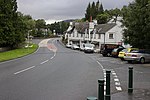Holbeck Ghyll
Michelin Guide starred restaurants in the United KingdomRestaurants in CumbriaTourist attractions in CumbriaWindermere, Cumbria

Holbeck Ghyll is a restaurant located in Windermere, Cumbria, England. "The late 19th century building was once Lord Lonsdale's hunting lodge and only became a hotel in the 1970s. It won a Michelin star in 1998 but lost it in 2014. It has failed to reclaim the star since. The restaurant is formal and the food a "contemporary take on French and British cuisine".Holbeck Ghyll was featured in The Trip, a 2010 BBC comedy starring Steve Coogan and Rob Brydon as fictionalised versions of themselves doing a restaurant tour of northern England.
Excerpt from the Wikipedia article Holbeck Ghyll (License: CC BY-SA 3.0, Authors, Images).Holbeck Ghyll
Holbeck Lane, South Lakeland Lakes
Geographical coordinates (GPS) Address Phone number Website Nearby Places Show on map
Geographical coordinates (GPS)
| Latitude | Longitude |
|---|---|
| N 54.4117 ° | E -2.9388 ° |
Address
Holbeck Ghyll Country Park Hotel
Holbeck Lane
LA23 1LU South Lakeland, Lakes
England, United Kingdom
Open on Google Maps










